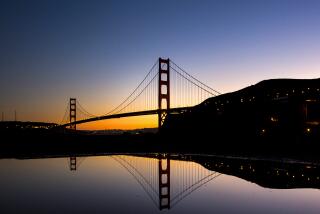Golden Gate Bridge: What’s wrong with trying to prevent suicides?
Many of those commenting on my May 25 Op-Ed, which called for a suicide barrier on the Golden Gate Bridge, seem to believe that people should be allowed to kill themselves without any preventative measures. That astounds me.
“SFJay09” put it this way: “People who want to kill themselves will find a way.... These people are just speaking their minds.” And “meshele01” said this: “Enough with bubble-wrapping the world to prevent boo-boos.”
How is it possible to be so uncaring?
If someone you love -- a spouse, parent, sibling, child or close friend -- wants to die, doesn’t have a fatal illness and can be saved, why wouldn’t you want to save them? Why wouldn’t you want to give people another chance at life?
Facts do not back up the “just let them jump” contingent.
According to a study done in the last decade by the Harvard School of Public Health, 90% of people who survive a suicide attempt don’t go on to kill themselves. Many, in fact, end up leading lives that are happy, healthy and productive. And had the commenters read all the way through my Op-Ed, they would have found a reference to a 1978 University of California study of 515 people who were stopped from jumping from the Golden Gate Bridge; 25 years later, 94% were still alive or had died by means other than suicide. Suicide is not inevitable.
It’s also important to keep in mind that when someone dies by suicide, it’s not just the victims and their families who suffer; it’s all of society. All of us miss out on the skills and talents that the victim has or could have developed -- future doctors, engineers, artists, caregivers, etc. The most common occupation of Golden Gate Bridge jumpers is student. The second-most common is teacher.
Also unaccounted for is the impact on witnesses -- despite the sick humor of “LuddNedd.” Seeing someone jump from the Golden Gate Bridge is traumatic. It’s not your choice to be a witness, but you’re affected anyway, sometimes as deeply as the families of victims. One witness talked about how the scene and the sound played over and over: “I cannot stand to look at the bridge anymore. I have witnessed how fast one falls…. It is too easy to climb over that railing.”
We have medians on freeways to prevent head-on collisions and guardrails on mountain roads to prevent cars from going over the side. We have stoplights and stop signs at busy intersections to prevent accidents, and seat belts and airbags to prevent injuries. We have safety locks on firearms to prevent accidental discharges, and lifeguards at pools and beaches to prevent drownings. All are in the interests of public safety. A bridge barrier to prevent suicides is no different.
If you’ve never lost someone you love to suicide, consider yourself lucky. You have the luxury of being unaffected. For everyone else, there is a never-ending pain, a pain that could have been prevented if, in the case of the Golden Gate Bridge, there were a suicide barrier.
ALSO:
An ailing wife takes her life; a husband is arrested
Assisted suicide: Jack Kevorkian was just a sideshow
Photos: Photographer Richard Misrach’s Golden Gate Bridge
More to Read
A cure for the common opinion
Get thought-provoking perspectives with our weekly newsletter.
You may occasionally receive promotional content from the Los Angeles Times.






